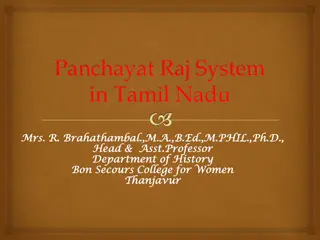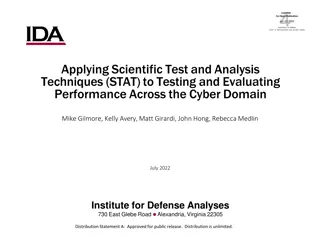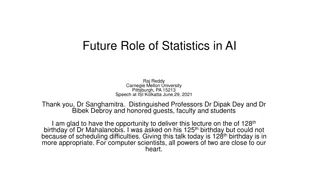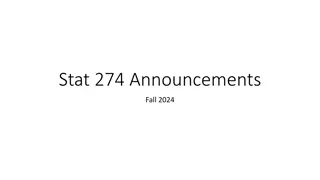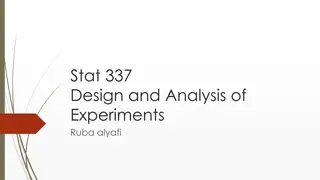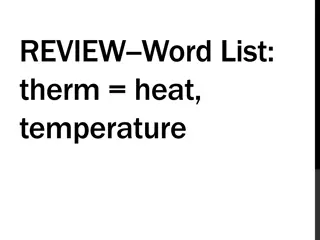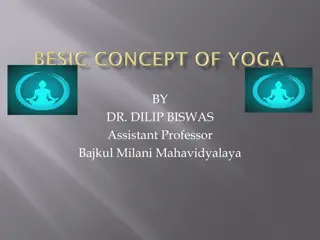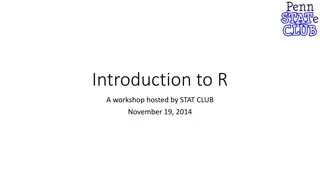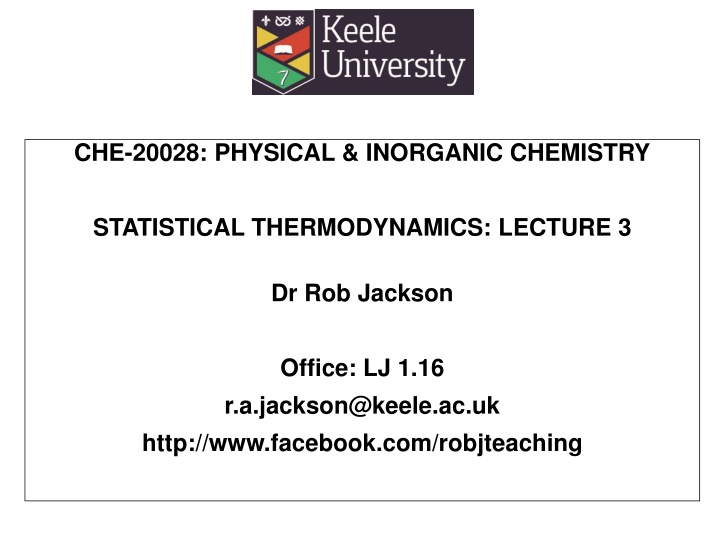
Statistical Thermodynamics Lecture on Gibbs Free Energy Calculation
Explore the calculation of Gibbs free energy in Statistical Thermodynamics Lecture. Understand topics like monatomic and diatomic gases, equilibrium, Boltzmann distribution, ionization reactions, and more. Get insights into the corresponding expressions for Gibbs free energy and practical examples in the field.
Download Presentation

Please find below an Image/Link to download the presentation.
The content on the website is provided AS IS for your information and personal use only. It may not be sold, licensed, or shared on other websites without obtaining consent from the author. If you encounter any issues during the download, it is possible that the publisher has removed the file from their server.
You are allowed to download the files provided on this website for personal or commercial use, subject to the condition that they are used lawfully. All files are the property of their respective owners.
The content on the website is provided AS IS for your information and personal use only. It may not be sold, licensed, or shared on other websites without obtaining consent from the author.
E N D
Presentation Transcript
CHE-20028: PHYSICAL & INORGANIC CHEMISTRY STATISTICAL THERMODYNAMICS: LECTURE 3 Dr Rob Jackson Office: LJ 1.16 r.a.jackson@keele.ac.uk http://www.facebook.com/robjteaching
Statistical Thermodynamics: topics for lecture 3 Summary from lecture 2 Calculation of the Gibbs free energy Monatomic gas Diatomic Gas Equilibrium and the Boltzmann distribution Calculation of equilibrium constants for ionisation reactions che-20028: Statistical Thermodynamics Lecture 3 2
Calculation of the Gibbs free energy - 1 In lecture 2 (slides 7-8) we saw that the internal energy can be obtained from the partition function using the expression: 2 NkT dq = 0 + U U ( ) q dT Similarly, we can get an expression for the Gibbs free energy. che-20028: Statistical Thermodynamics Lecture 3 3
Calculation of the Gibbs free energy - 2 The corresponding expression for the Gibbs free energy for a gas containing N molecules is: q = NkT G G ( ) ln 0 N So, thermodynamic property from the partition function only (other terms are constant). once again, we can obtain a che-20028: Statistical Thermodynamics Lecture 3 4
The Gibbs free energy for a monatomic gas - 1 To use the expression given in the previous slide, all we have to do is substitute q by the relevant partition function(s). For a monatomic gas, q = qT (seelecture 2 slide 9). We substitute for q, and replace V by nRT/p (ideal gas equation), and obtain, for a mole of gas, the expression given on the next slide: che-20028: Statistical Thermodynamics Lecture 3 5
The Gibbs free energy for a monatomic gas - 2 The expression is: / 5 2 ( ) ph ( ) / 3 2 m kT 2 = G G ( ) RT ln 0 m m 3 Note: Gm is the Gibbs free energy per mole. Under standard conditions, p= p = 105 Pa. So we can calculate Gm Gm(0) for any monatomic gas. What does this mean? che-20028: Statistical Thermodynamics Lecture 3 6
Example: calculate the Gibbs free energy for He(g) at 298K m (He) = 4.0026 x 1.661 x 10-27 kg So Gm Gm(0) = - RT ln [A] [A] = (2 x 4.0026 x 1.661 x 10-27)3/2 (1.381 x 10-23 x 298)5/2 / [105 x (6.626 x 10-34)3] = 8.538 x 10-39 x 1.086 x 10-51 / 290.91 x 10-97 [A] = 319733.39 Gm Gm(0) = -8.314 x 298 x ln (319733.39) = -31403.83 J mol-1 che-20028: Statistical Thermodynamics Lecture 3 7
The Gibbs free energy for a diatomic gas - 1 The procedure is the same as for a monatomic gas, except that q = qT qR (we neglect vibrational motion). The expression just needs to have the qR terms included: ( / 5 2 ) ph ( ) / 3 2 2 m kT kT = G G ( ) RT ln 0 m m 3 hB Which can be tidied up to give (next slide): che-20028: Statistical Thermodynamics Lecture 3 8
The Gibbs free energy for a diatomic gas - 2 / 7 2 ( ) ( 4 ) / 3 2 m kT 2 = G G ( ) RT ln 0 m m Bph So for any diatomic gas we can calculate Gm Gm(0), if we know the value of m and B. See question 3 (iii) For nitrogen (N2), B= 1.9987 cm-1, = 2 convert B to a frequency! che-20028: Statistical Thermodynamics Lecture 3 9
Chemical equilibrium: the statistical basis At equilibrium we have a mixture of products and reactants. According to statistical thermodynamics, the product and reactant molecules will be distributed over a range of energy levels according to a Boltzmann distribution. We can illustrate this by two reaction scenarios : che-20028: Statistical Thermodynamics Lecture 3 10
(a) A normal endothermic reaction The diagram shows the occupation of energy levels for reactants, R (grey) and products, P (blue). The reactant molecules are in the lower energy levels, and the population of the product levels is less. Reaction is endothermic. che-20028: Statistical Thermodynamics Lecture 3 11
(b) An endothermic reaction where products dominate The energy levels for the product, P, are closely spaced, so even though they are of higher energy, their population will be higher, and the products will dominate equilibrium. High entropy leads to closely spaced levels. An entropically favoured reaction. at che-20028: Statistical Thermodynamics Lecture 3 12
Calculating equilibrium constants Equilibrium constants can be calculated if we know the partition functions of the products and reactants: q P = K exp( E / kT ) r 0 q R rE0 is the energy difference between products and reactants. This equation links equilibrium thermochemistry. spectroscopy to che-20028: Statistical Thermodynamics Lecture 3 13
Ionisation reactions For an ionisation reaction, replace rE0 by the ionisation energy, I. e.g. Na(g) Na+(g) + e- The products are a sodium ion and an electron. The electron translational contributions to q, and the ion has just a translational contribution. The reactant will have both translational and spin contributions to its partition function (why spin?) has spin and che-20028: Statistical Thermodynamics Lecture 3 14
K for an ionisation reaction So qp = q(Na+) q(e-), qr = q(Na) K = [(q(Na+) q(e-))/q(Na)] exp (-I/RT) Obtaining the expressions for the partition functions and substituting in the above equation gives: Question 3 (iv) on the problem sheet applies this equation. che-20028: Statistical Thermodynamics Lecture 3 15
Summary We have seen how to calculate Gibbs free energy for the specific examples of: A monatomic gas A diatomic gas The statistical interpretation of equilibrium has been introduced. The determination of equilibrium constants by statistical thermodynamics introduced and illustrated for ionisation reactions. has been che-20028: Statistical Thermodynamics Lecture 3 16











